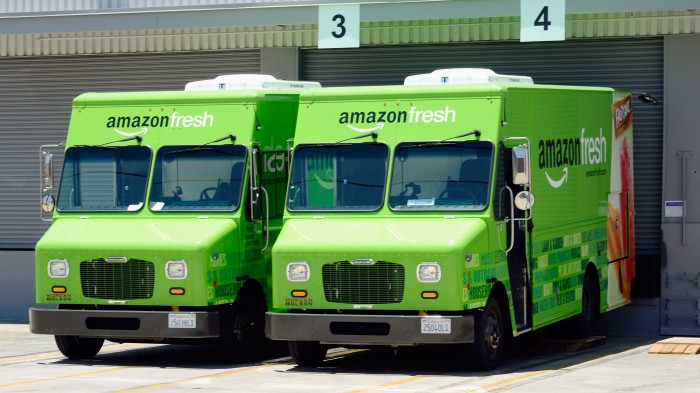New Patents Hint That Amazon and Google Each Have Plans to Compete with Uber
Uber appears to be leading the charge to develop autonomous taxis and delivery vehicles. But a pair of patents show that tech giants like Amazon and Google have no intention of being left behind.
Both patents were only recently published, but both were originally filed in 2015. That means that although Uber has been making headlines for many of its innovations over the past 12 months, other companies haven’t necessarily been slouching.
While Google is already trialing a small ride-sharing service in San Francisco, one of the new patents describes how it plans to pair self-driving vehicles with ride-hailing apps. The problem it tries to overcome: how to negotiate a pickup location if an autonomous car can’t safely or accurately navigate to the passenger like a human driver could.

Alphabet’s autonomous car division, Waymo, is now targeting commercial applications of its technology by working with automakers, which means it no longer plans to build its own vehicles. But the company does plan to start trials of robotic Chrysler Pacifica taxis this year.
In doing so, it will be squaring up directly with Uber, which is testing autonomous taxis in Pittsburgh (along with a brief experiment in San Francisco that got shut down). Waymo may even make use of the technology described in the Google patent to help the test along.
Meanwhile, a patent filed by Amazon describes a way for autonomous vehicles to cope with reversible lanes, where traffic flow changes direction based on demand. It’s a road management trick used to optimize relatively narrow roadways, but it could confuse self-driving vehicles if they weren’t somehow aware of the changes.
Amazon's solution to the problem isn’t as interesting as what it means for the company itself. Some rumors have swirled in the past that the e-tailer has been working on its own self-driving vehicle plans. Such a direction would certainly dovetail nicely with its overarching vision, to take on more of its own delivery logistics. The new patent adds weight to the speculation.
But again, Amazon would be competing with Uber. The ride-hailing company has been backing autonomous 18-wheelers originally developed by Otto, and also has plans to do for trucking what it did for taxis, by introducing surge charging to freight.
Uber, then, has publicly embraced self-driving vehicles heavily, making it appear to be at the forefront of the race to automate the ferrying of goods and people. But it looks like it may yet have some serious competition to shrug off in the longer term.
(Read more: The Guardian, The Verge, “What to Know Before You Get In a Self-Driving Car,” “Uber and Amazon Want to Muscle In on the Shipping Industry,” “Alphabet Sets Up a New Company to Commercialize Autonomous Car Technology”)
Keep Reading
Most Popular
Large language models can do jaw-dropping things. But nobody knows exactly why.
And that's a problem. Figuring it out is one of the biggest scientific puzzles of our time and a crucial step towards controlling more powerful future models.
How scientists traced a mysterious covid case back to six toilets
When wastewater surveillance turns into a hunt for a single infected individual, the ethics get tricky.
The problem with plug-in hybrids? Their drivers.
Plug-in hybrids are often sold as a transition to EVs, but new data from Europe shows we’re still underestimating the emissions they produce.
Stay connected
Get the latest updates from
MIT Technology Review
Discover special offers, top stories, upcoming events, and more.